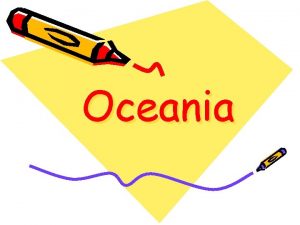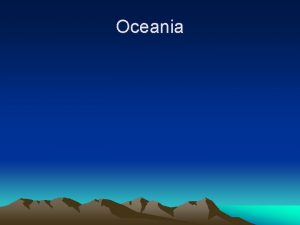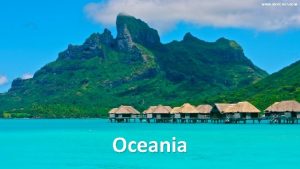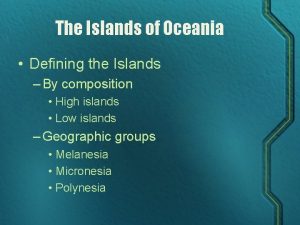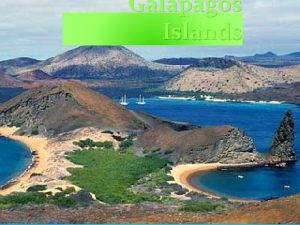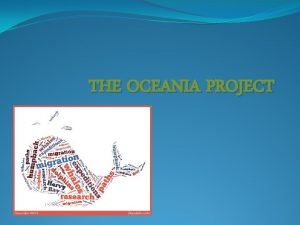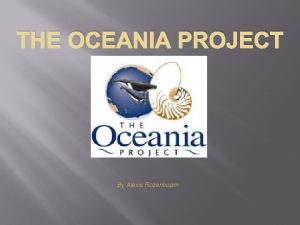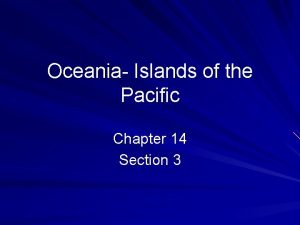Oceania 1 THE ISLANDS OF OCEANIA Oceania consists

















- Slides: 17

Oceania 1

THE ISLANDS OF OCEANIA • Oceania consists of over 25, 000 islands, including the island continent of Australia. Archeologists have determined that the islands have been inhabited for tens of thousands of years. Because of the expansive chronological span of migrations, Pacific cultures vary widely. These island groups came to Western attention as a result of the extensive explorations and colonization hat began in the 16 th century and reached its peak in the 19 th century.

Pacific Regions • In 1831, the French explorer Jules Sébastien César Dumont d'Urville proposed the division of the Pacific into major regions based on general geographical, racial, and linguistic distinctions. Despite its limitations, his division of Oceania into the areas of Melanesia ("black islands"), Micronesia ("small islands"), and Polynesia ("many islands") continues to be used today. Largely as a result of colonial and missionary intervention in the 18 th through 20 th centuries, many Oceanic cultures abandoned traditional practices and production of many of its art forms ceased.

Melanesia • Melanesia includes New Guinea, the islands of the Bismarck Archipelago, the Solomon Islands, New Caledonia, Vanuatu, and the Fijian Islands. The art forms of Melanesia suggest a variety of historical overlays of styles and symbolism. Their cults and art forms address a host of legendary ancestral and nature spirits. • Mortuary rites and memorial festivals are a central concern of the Austronesian-speaking peoples who live in the northern section of the island of New Ireland in Papua New Guinea. The term malanggan refers to both the festivals held in honor of the deceased and the carvings and objects produced for these festivals. Among the many Malanggan carvings produced – masks, figures, poles, friezes, and ornaments – are tatanua masks. Tatanua represent the spirits of specific deceased people.

Tatanua mask, New Ireland. Wood, shell, lime, and fiber, 1’ 5 3/4” high. Otago Museum, New Zealand. 5

Micronesia • The people of Micronesia are frequently organized around chieftainships with craft and ritual specializations, and their religions include named deities as well as honored ancestors. Characteristics such as simplification and geometric abstraction of natural forms often differentiate Micronesian art from the arts of Melanesia, Polynesia, and Australia.


Men’s ceremonial house (bai), from Belau (Palau), Republic of Belau. Staatliche Museen zu Berlin Preussischer Kulturbesitz. Ethnologisches Museum. 8

POLYNESIA • The inhabitants of Polynesia brought complex sociopolitical and religious institutions with them. Polynesian societies typically are aristocratic, with ritual specialists and chiefs heading elaborate political organizations. • Polynesians often make art forms for upholding spiritual power, or mana. The counterpart to mana, tapu, creates a dynamic opposition of forces dominating Polynesian social and religious concepts and practices. In addition to figural sculptures, Polynesians make decorative barkcloth (tapa), one of the major art forms by Polynesian women. Barkcloth plays a crucial role in society as clothing, bedding, and gift articles.

Figure 31 -10 MELE SITANI, decorated barkcloth (ngatu) with two 10 bird (manulua) designs, Tonga, 1967.

Tattooed warrior with war club, Nukahiva, Marquesas Islands, 19 th century. Engraving. Polynesian nobles and warriors accumulated various tattoo patterns to increase their status, mana, and personal beauty. An engraving illustrates a Marquesan warrior covered with elaborate tattoo patterns, which seem to accentuate different areas. 11

Hawaii • The Hawaiians developed the most highly stratified social structure in the Pacific. • Because perpetuation of the social structure was crucial to social stability, most of the material culture produced (before American control) in Hawaii was intended to visualize and reinforce the hierarchy. Chiefly regalia was prominent part of artistic production.

Feather cloak ('ahu'ula), from Hawaii. Red i 'iwi, yellow 'o'o, and black feathers, olona 13 cordage and netting, 4’ 8 1/3” x 8’. Bishop Pauahi Museum, Honolulu.

Kukai‘limoku (war god), temple image, from Hawaii. Wood, 2’ 5 3/4” high (figure only). British Museum, London. The Hawaiians placed deities such as this image of the war god Kukailimoku in semicircular rows within an enclosed temple area (heiau). Although styles differ in the various islands, the figures share a tendency toward athleticism and expressive defiance. 14

Moai (statues), Anakena, Rapanui (Easter Island). Stone. 15

OCEANIC ART TODAY • Many of the traditional arts of Oceania are not practiced today, for they no longer have critical roles insuring cultural continuity and survival. Yet, in several places, these arts have been revitalized. New cultural awareness has led artists to express their inherited values in a resurgence of traditional arts. • One example of cultural renewal is the school of New Zealand artists who draw on their Maori heritage formal and iconographic inspiration. Historic Maori woodcarving reemerges in Cliff Whiting's Tawhiri-Matea (God of the Winds), designed for a modern environment, which depicts the Maori creation myth. In uniting native tradition with modernist design, the artist is renewing Maori cultural life in terms of its continuity in art.

Figure 31 -19 CLIFF WHITING (TE WHANAU-A-APANUI), Tawhiri. Matea (God of the Winds), Maori, 1984. Oil on wood and fiberboard, approx. 6' 4 3/8" x 11' 10 3/4". Meteorological Service of New Zealand Ltd. Collection, Wellington. 17
 Khi nào hổ mẹ dạy hổ con săn mồi
Khi nào hổ mẹ dạy hổ con săn mồi Dot
Dot điện thế nghỉ
điện thế nghỉ Các châu lục và đại dương trên thế giới
Các châu lục và đại dương trên thế giới Nguyên nhân của sự mỏi cơ sinh 8
Nguyên nhân của sự mỏi cơ sinh 8 Bổ thể
Bổ thể Làm thế nào để 102-1=99
Làm thế nào để 102-1=99 Thiếu nhi thế giới liên hoan
Thiếu nhi thế giới liên hoan Phối cảnh
Phối cảnh Alleluia hat len nguoi oi
Alleluia hat len nguoi oi Một số thể thơ truyền thống
Một số thể thơ truyền thống Hệ hô hấp
Hệ hô hấp Cong thức tính động năng
Cong thức tính động năng Bảng số nguyên tố
Bảng số nguyên tố Tư thế ngồi viết
Tư thế ngồi viết Tỉ lệ cơ thể trẻ em
Tỉ lệ cơ thể trẻ em đặc điểm cơ thể của người tối cổ
đặc điểm cơ thể của người tối cổ Các châu lục và đại dương trên thế giới
Các châu lục và đại dương trên thế giới


















